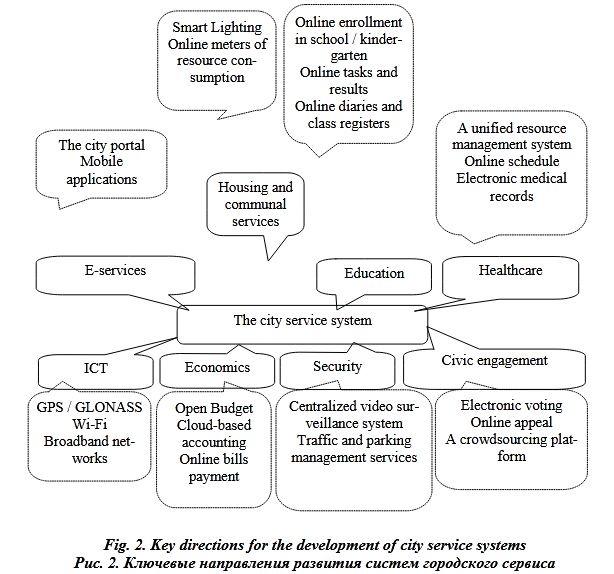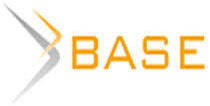Комплексный подход внедрения информационных технологий в систему городского сервиса
Aннотация
Информатизация и цифровизация – один из главных трендов развития современных городов. Необходимо максимально активно внедрять электронные услуги и сервисы по всем направлениям городской жизни – от здравоохранения и образования до безопасности. Развитие цифровой среды – требование времени и важный показатель городского комфорта. Проведен анализ развития современных информационных технологий в городской среде. Городской сервис является частью системы «умного города» и реализован в различных функциональных областях. Часть сервисных услуг в настоящее время успешно реализована посредством портала госуслуг. Развитие цифровой среды – требование времени и важный показатель городского комфорта. В современных условиях происходит постепенный пересмотр подходов к управлению городским развитием, которое все больше опирается на передовые технологические решения, цифровизацию и платформизацию. Отметим, что максимальная реализация городского информационного сервиса зависит от соблюдения нескольких условий: город должен быть технологически оснащен; должен быть реализован принцип открытости данных и соблюдено условие совместимости данных.
Ключевые слова: городской сервис, информационные услуги, цифровизация, информационно-коммуникационные технологии
К сожалению, текст статьи доступен только на Английском
Introduction. The rapid pace of penetration of digital technologies into all spheres of life of modern society entails a change in the usual models of the economic and social structure of states. In the wake of this trend, the world's leading countries are relying on digitalization of the economy to maintain leadership. Information technology allows city authorities to interact directly with communities and urban infrastructure and monitor what is happening in the city, how the city is developing and what ways can improve the quality of life. The analysis of Russian and foreign practices as well as theoretical research shows that the servicization and digital transformation of socio-economic systems are based on digital platforms that integrate economic, social and technological processes and form digital service ecosystems. Information and communication technologies are used to improve the quality, productivity and interactivity of city services, reduce costs and resource consumption, and improve communication between city dwellers and the state. The application of smart city technology is evolving to improve the management of urban flows and quick response to complex tasks. In view of the foregoing, the relevance of the research topic is explained.
The aim of this study is to examine the mechanism of urban information service development and to elaborate a model of urban information service.
Materials and methods. The statistical data characterizing the development of digital technologies in the service sector, analytical reports of studies of the digital economy market in the Russian Federation and the world, the results of monitoring the quality of the provision of state and municipal services in electronic form in the Russian Federation and analysis of indicators of the development of the information society were used as a source material. Theoretical and comparative analysis was used as a research methodology.
The results and discussion. Modern information technologies affect the modern economy and form a new type of economy – the digital economy, the main elements of which are digital ecosystems (Ivanov, 2020). The application of smart city technology is being developed with the aim of improving urban flow management and quick response to complex tasks (Gupta, 2018; Liu, 2018). However, the term “smart city” remains unclear and therefore implies many interpretations. In the study, the term “smart city” will refer to the urban planning concept of integrating multiple information and communication technologies (ICT), including Internet of Things (IoT) systems for managing urban infrastructure: transport, education, healthcare, utilities, security, etc. The aim of the smart city is to improve the quality of life of residents by using urban informatics technology to improve service efficiency and meet the needs of residents. A smart city is data-driven, and data management enables municipal services to improve the quality of life of the population (Klimova, 2014; Muravleva, 2018). Data sources include video cameras, various sensors, information systems, etc. (Galichina, 2020; Guryanov, 2020).
According to the results of 2019, the volume of the market for solutions for smart cities in Russia exceeded 81 billion roubles, more than 2.5 thousand solutions in the field of smart cities were implemented, of which:
- 40% – are building automation projects;
- 33% – are energy and heat supplies digitalization projects;
- 32% – are public safety monitoring projects;
- 27% – are waste management initiatives (Indicators of the…, 2021).
City service is part of the smart city system and is realized in various functional areas. Some of the services are now successfully implemented through the portal of public services (Public services…, 2021).
Nowadays, some services have now been successfully implemented through the portal of public services. The portal of state services has been operating since 2009, and today it is one of the most popular government websites in the world (The portal…, 2021). According to Similarweb, it is ranked second most visited in the Law and Government category, behind only the UK government services portal (The most digital…, 2021). The public service portal is operated by PAO “Rostelecom” with the participation of AO “RT Labs”.
The number of citizens registered on the portal of public services exceeded the 100 million mark in 2019, of whom 75% are aged 25-54 and 25% are over 55 years old. During 2019, an average of 1.4 million people became new users each month (Information product…, 2021). The citizens most often use the services for making an appointment with a doctor and kindergarten, obtaining information on pension savings, registering vehicles, applying for an exam with the State Motor Vehicle Inspectorate and obtaining a driving licence. Also, among the top ten most popular services include the processing and issuance of Russian and foreign passports, registration at the place of stay and at the place of residence, issuance of certificates of existence or lack of a criminal record.
Among the most popular services used by citizens in 2019 were making a doctor's appointment, the notifications about personal account status in the Russian Pension Fund, the automobile registration, the enrolment in kindergarten, the conduct of examinations and the issuance of driving licences.
An analysis of foreign experience in this area showed that in the G20 countries, on average, the number of people who use government services in the online format had increased from 30% in 2010 to 46% in 2019, with Mexico and Russia showing the largest growth (Rozhdestvenskaya, 2018).
In 2019, 12% of citizens of the European Union reported that they wanted to get a public service online, but were unable to do so due to technical problems. A particularly large number of technical problems were recorded in Slovenia (31%) and Germany (29%). Another reason for refusing to use the Internet to interact with government authorities is the insufficient level of protection of personal data. In France, 79% of the population used online government services in 2020, the system of public services in online format is also well-developed in Canada (76% of the population), the UK (65% of the population). On average 60% of the population of the EU countries are users of online services. Meanwhile, the main users are people aged 25 to 54. The use of online services is widespread in France – 62% of citizens of the older age group (over 55) are active users, in Canada – 60% (Abdrakhmanova, 2020).
The lowest rates in Italy where 20% of the population use online public services. It should be noted that this indicator has remained unchanged since 2010, while in most countries there has been a significant increase in the activity of citizens in using modern information technologies to receive public services (Fig. 1).
Since 2017, “smart cities” have begun to develop in Russia, and this has become one of the priorities of the “Digital Economy” national project with a total budget of RUB 1.63 trillion. In 2018, a roadmap for the “Smart City” project was approved, suggesting that by 2024 the state will spend 13 billion roubles to create a bank of solutions for the digitalization of urban economy and introduce them in pilot cities.
Now the project involves 177 cities with a population of over 100,000 people each. All of them will have to implement a minimum smart city standard by 2024:
- to create platforms for taking into account citizens' opinions on the model of the
Moscow project “Active Citizen”;
- unified dispatching services for the management of urban communal infrastructure;
- to introduce intelligent management of public and municipal transport and waste collection;
- to reduce electricity consumption;
- to install security cameras (Kostin, 2019).
The system of city service includes a set of measures for the high-quality satisfaction of needs and interests of individuals (citizens) or enterprises in various spheres of daily activity by providing services (Fig. 2).
It should be pointed out that in the current epidemiological situation, the development of information electronic services is of particular importance, as it allows keeping distance and observe safety as much as possible.
The monitoring of the quality of the provision of public and municipal services electronically during which 1336 priority services were studied, provided in 85 constituent entities of the Russian Federation, showed that finance and trade are currently the most developed in terms of digitalization (Fig. 3).

The development of the digital environment is a requirement of the times and an important indicator of urban comfort (Slinkova, 2015). A transition to an integrated digital urban ecosystem is needed that would respond to emerging challenges, contribute to meeting the needs of all participants (residents, businesses, authorities) and ensure a more effective integration of individual elements of urban infrastructure. The urban information service model is shown in Figure 4.
It is important to note that the maximum realization of urban information service depends on compliance with the several conditions. First, the city must be technologically equipped. It is about tools for data fixation and collecting – sensors, video surveillance cameras and similar devices that gather information on a variety of processes (traffic, pedestrian movement, air quality, noise levels, etc.). This data, in turn, can be supplemented with information that is aggregated by other participants in the urban ecosystem (for example, mobile operators).
Secondly, the open data principle must be implemented. In general, open data is data generated and owned by public or private entities, provided on a non-competitive, license-free basis for commercial and non-commercial use (Elokhov, 2019). Free access to data should be provided not only at the level of interdepartmental municipal interaction, but they should also be open for use by citizens and businesses. This approach contributes to greater transparency of processes, which means a higher level of trust between individual participants in the urban ecosystem.
Thirdly, the condition of data compatibility must be met (Ivanov, 2019). Decisions on specific development issues often require the simultaneous recording and analysis of multiple data streams.
Nowadays, it is necessary to introduce e-services and services in all areas of city life actively from healthcare and education to security. The development of the digital environment is a requirement of the times and an important indicator of urban comfort. In modern conditions, there is a gradual revision of approaches to urban development management, which increasingly relies on advanced technological solutions, digitalization and platformization. A transition to an integrated digital urban ecosystem is needed that would respond to emerging challenges, contribute to meeting the needs of all participants (residents, businesses, authorities) and ensure a more effective integration of individual elements of urban infrastructure.
Conflicts of Interest: the author have no conflict of interests to declare.
Информация о конфликте интересов: автор не имеет конфликта интересов для декларации.



















Список литературы
Абдрахманова Г.И., Баскакова О. Е., Вишневский К. О., Гохберг Л. М. и др. Тенденции развития интернета в России и зарубежных странах: аналитический доклад. М.: НИУ ВШЭ, 2020. 144 с.
Елохов В. В., Хмельченко Е. Г. Умный город: цифровые технологии в развитии городской среды // Проблемы управления – 2019: материалы 27- Всероссийской студенческой конференции. Государственный университет управления. 2019. С. 103-105.
Галичина А. М. Инновационные цифровые технологии на пути к «Умному городу» // Инновационные научные исследования: теория, методология, практика: сборник статей XXI Международной научно-практической конференции: в 2 ч. Пенза, 2020. С. 11-19.
Госуслуги в 2019 году: главные события и факты. URL: https://www.gosuslugi.ru/help/news/2019_12_30_results_of_the_year (дата обращения 14.03.2021)
Гурьянов Н. Ю., Гурьянова А .В. Цифровая глобализация в контексте развития цифровой экономики и цифровых технологий // Вестник Московского государственного областного университета. Серия: Философские науки. 2020. № 3. С. 63-69.
Индикаторы цифровой экономки 2019: статистический сборник. URL: https://www.hse.ru/data/2019/06/25/1490054019/ice2019.pdf (дата обращения 05.03.2021)
Информационные услуги. URL: https://www.sigirgroup.ru/stati/informatsionnye-uslugi.html (дата обращения 14.02.2021)
Иванов А. Л., Шустова И. С. Исследование цифровых экосистем как фундаментального элемента цифровой экономики // Креативная экономика. 2020. Том 14. № 5. С. 655-670.
Иванов И. О. Московская модель: умные дома в умном городе // Вестник университета Правительства Москвы 2019. №4 (46). С. 15-20
Хабибулина А.Р., Вишневская Е.В. Разработка системы критериев для оценки уровня туристского сервиса урбанизированного пространства //
Научный результат. Технологии бизнеса и сервиса. 2020. Т. 6. № 3. С. 3-13.
Климова Т. Б., Вишневская Е. В. Мобильные технологии в развитии туристских дестинаций // Научное обозрение. 2014. № 8-2. С. 666-669.
Костин К. Б., Березовская А. А. Современные технологии цифровой экономики как драйвер роста мирового рынка товаров и услуг // Экономические отношения. 2019. № 2. С. 455-480.
Муравлева Т. В. Проект «Цифровой город» как вектор развития цифровой экономики в регионе // Экономическая безопасность и качество. 2018. № 3 (32). С. 8-11.
Рождественская И. А. Зарубежный опыт применения цифровых технологий в управлении крупными городами // Финансовая экономика. 2018. № 7. С. 2380-2382.
Самые цифровые страны мира: рейтинг 2019 года. URL: https://hbr-russia.ru/innovatsii/issledovaniya/818884 (дата обращения 19.02.2021).
На портале «Госуслуги» свыше ста миллионов зарегистрированных пользователей. URL: https://digital.ac.gov.ru/news/1621/ (дата обращения 10.03.2021).
Gupta A., Deokar A., Iyer L. et al. Big Data & Analytics for Societal Impact: Recent Research and Trends. // Information Systems Frontiers. 2018. №20 (2). рр. 185-194. doi: 10.1007/s10796-018-9846-7.
Liu Z. Research on the Internet of Things and the development of smart city industry based on big data. // Cluster Computing.2018. № 21 (1), pp. 789-795. doi: 10.1007/s10586-017-0910-8.
Slinkov A. M., Vishnevskaya E. V., Nezhelchenko E. V., Slinkova O. K., Yasenok S. N., Zdorovets Yu. I. Actualization of ways to introduce Russian education into digital economy realities // Advances in Economics, Business and Management Research. Proceedings of the Russian Conference on Digital Economy and Knowledge Management (RuDEcK 2020). 2020. С. 491-494.
Slinkova O. K. Globalization of the economy and socio-cultural rinks // Научный результат. Технология бизнеса и сервиса. 2015. Т. 1. № 4 (6). С. 29-32.